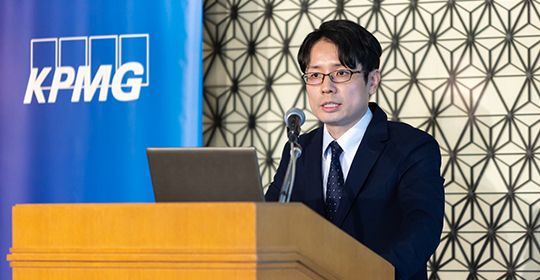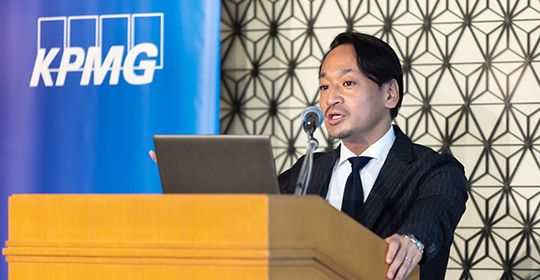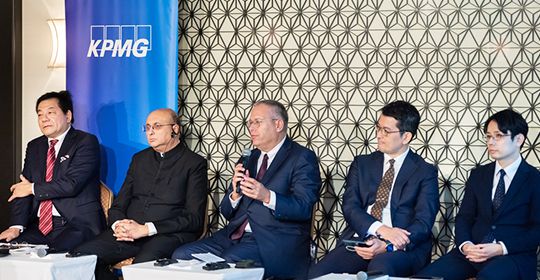The second Trump administration takes office in January 2025. How will President Trump's pursuit of a streamlined American economy affect global markets, and how should Japanese companies prepare for geopolitical risks?
This article has been edited based on a November 15 forum co-hosted by KPMG Consulting and The Asia Group in 2024, “Business Outlook after the U.S. Presidential Election: Rethinking Medium- and Long-Term Management Strategies and Supply Chains.”
Diplomacy with China will shift from cooperation with allies to bilateral transactions
Mr. Christopher B. Johnstone
Managing Principal, The Asia Group and Senior Associate (Non-resident) of the Japan Chair, Center for Strategic and International Studies
I would like to offer a perspective on the incoming Trump administration's foreign policy, particularly with respect to the Indo-Pacific region, and the geopolitical implications that may result from this change in administrations.
I would like to begin by clarifying that there may be multiple foreign policy directions the incoming second Trump administration could take, and those policies may well be in conflict or even contradictory to each other. This phenomenon has already been observed during the first Trump administration. Even in the Biden administration, China has been a central issue for U.S. foreign policy.
The key words in this context have been "Invest, Align, and Compete." In other words, rather than demanding some direct change in China, the approach has been to modify the environment surrounding China through investment in the United States (such as the Inflation Reduction Act and the CHIPS and Science Act), export control of sensitive technologies in cooperation with allies, and proactive actions to compete with China in innovation.

The Asia Group Mr. Christopher B. Johnstone
On the economic front, the United States has restricted China's access to advanced technologies like semiconductors and related equipment that could be converted to military use. It adopted a so-called "small yard, high fence" approach (tightly targeted export controls), encouraging allies and partners to take similar measures as the United States, including export and investment restrictions. Efforts to maintain a common front with allies on China policy were a major feature of President Biden's diplomacy.
Like President Biden, President-elect Trump has placed China at the center of his economic strategy agenda, but his approach is fundamentally different.
In keeping with his "America First" philosophy, Trump aims for a broader decoupling of the United States and Chinese economies. For example, he may significantly increase tariff rates on Chinese imports or revoke China’s permanent normal trade relations (PNTR) status. For Trump, the key is to reduce the U.S. trade deficit. Unlike President Biden, who cooperated with allies and worked to shape the environment around China, Trump tends to prioritize bilateral deals that do not rely on allies.
The emphasis on "give and take" and a strong preference for bilateral over multilateral relationships is a pattern already seen during the first Trump administration. Trump sees tariffs as a card to play in trade negotiations. I believe that he will take major action early in his second administration, which will bring us into an era of difficult U.S.-China relations.
Moving our attention to foreign policy in other regions; first, it will be more likely that the U.S., Japan, and South Korea come to the table together for discussions less frequently. Trump prefers bilateral engagement, an area where he can wield the most influence. In these engagements, he may pressure Japan, South Korea, and Taiwan to increase defense spending and/or purchase U.S.-made equipment.
In addition, the United States approved significant arms sales to and boosted its diplomatic engagement with Taiwan during the first Trump administration. However, Trump has since expressed dissatisfaction with defense spending on Taiwan and has questioned Taiwan’s importance. The future of U.S. foreign policy toward Taiwan remains uncertain, with the potential for abrupt change in direction.
The impact of America’s China policy on supply chains
Amb. Kurt Tong
Managing Partner, The Asia Group
Let me discuss a few inevitable and potential developments that may take shape during President Trump's upcoming four-year term.
Trump's Asia policy is often described using the “three T’s”: Tariffs, Technology, and Transactionalism.
To begin with “tariffs,” Trump is likely to increase tariffs on China. U.S. imports from China will decrease, which will have a secondary impact on supply chains.
For "technology," Trump will focus on blocking certain goods and technologies that may advance its military capabilities from entering China. Particular focus will be on artificial intelligence and computing, but it could extend to other technology areas, including the life sciences.

The Asia Group Amb. Kurt Tong
In the Biden administration, the relationship with China was competitive but with an atmosphere of willingness toward managing relations. However, Trump has no such intention. China is a competitor, which will lead to a period of “transactionalism and negotiation.” These changes will likely lead to economic decoupling.
So then, how will this affect Japan? During his presidential campaign, Trump mentioned that he would impose a uniform 10 to 20 percent tariff on all imports, which seems unlikely to become actual policy. However, I believe it is very possible that Trump will foster an environment where Japanese companies are unilaterally regarded as "bad actors" in the United States, for example, by taking political steps to strongly criticize any behavior that appears to not be in the best interests of the United States.
The first specific impact on Japanese companies is inflation. Trump's fiscal, monetary, and trade policies will likely lead to a stronger dollar, affecting sales and revenue in the United States. In addition, there may be a new round of trade negotiations between Japan and the United States, as seen during the first Trump administration. If this happens, Japanese companies would need to consider how to position themselves in these negotiations and maximize their value.
If a Japanese company exports goods manufactured in China to the United States, not only will it be subject to tariffs, but its entire supply chain could be called into question. The question will be how closely a Japanese company's supply chain is tied to Chinese companies and how threatening it is perceived to U.S. economic security.
It is important to note that the criteria for judging what constitutes a "minor problem" and a "major threat" in the context of relations with Chinese companies differ greatly between Japan and the United States. Japanese companies need to be prepared, as these judgments will be made through the perspective of politics and economic security.
The world will likely head into an era defined by protectionism. The United States will aggressively raise tariffs, while China in turn raises tariffs on the United States. Should this escalate, China may respond in the economic sphere, for example, by imposing further export restrictions on raw materials used by companies across many supply chains.
With regard to supply chains, the U.S. government and other governments are paying greater attention to security than supply efficiency. Going forward, supply chains are likely to be shortened and fragmented.
Let me also turn your attention to Ukraine. My personal belief is that, even if Trump and Russian President Vladimir Putin negotiate, there will not be an end to the war, and that the situation will become even more complicated. An important benchmark will be the possible negotiations between Trump and Chinese President Xi Jinping in late 2025.
Intelligence functions required of Japanese companies in an era of change
Mitsushiro Niibori
Associate Partner, KPMG Consulting Co., Ltd. (Attorney at Law)
The hallmark of Trump 2.0 will be its emphasis on economic streamlining, where U.S. interests are put first. This administration will be reluctant to subsidize EVs, for which demand is growing slower than expected, or to curb the use of fossil fuels. It will attempt to reduce energy costs by reverting to fossil fuels as a countermeasure against inflation.
As for trade with foreign entities, the incoming administration has suggested universal and uniform tariffs, higher tariffs on non-China countries such as Mexico, and tighter restrictions on indirect exports. Since these measures may cause opposition from other countries and inflation, these will require close attention to adjustment processes.
In capturing the megatrends that are to come, it will be increasingly important to reconcile with positions that may differ from the previous policies and values espoused by Western countries. In the Global South, including African countries, India, and Indonesia, we can expect to see a growing presence in the political and economic spheres as the populations of these countries increase.

KPMG Consulting Mitsushiro Niibori
However, they often maintain a certain distance from the policies and values of Western countries, as seen, for example, in their positions on the war in Ukraine. Even in the West with regard to sustainability, we are beginning to see a movement against climate change measures because of their economic burden. The fact that Trump, who is reluctant to take action on climate change, has gained support is one indication of this.
In this increasingly uncertain and complex business environment, it is important to strengthen business intelligence. It will be necessary not only to simply share and collect information, but also to be carefully selective with information, then to analyze and make this information meaningful by capturing the needs of decision makers. However, few companies are currently able to establish and utilize the intelligence cycle as a process, in which the intelligence function is used to plan policies.
In order to utilize the intelligence function, it is important to identify its purpose and potential outputs for utilization, and to design hypothetical scenarios with an awareness of the timeframe, as well as to have an organized understanding of events that could become inflection points for future trends. In addition, to improve the quality and objectivity of information, it is necessary to utilize external networks, including experts, and forecasts based on AI and data analysis.
Rapidly adaptable management systems in a highly uncertain world
Tomonori Hamada
Partner, KPMG Consulting Co., Ltd.
In the midst of a drastically changing business environment, we have seen a number of situations in which conventional management planning approaches, centered on medium-term management plans, have become dysfunctional. This has happened because business environments are rapidly and drastically changing even after a medium-term management plan is formulated, meaning that the plan’s assumptions quickly crumble.
Meanwhile, since many companies disclose their medium-term management plans, they also face great costs in external communication with investors and other stakeholders about root cause analysis and recovery plans when revising their medium-term plans. This has led many to ask the question, what is the point of having a medium-term management plan?

KPMG Consulting Tomonori Hamada
To overcome this situation, it is necessary to build a long-term vision-driven management system based on the assumption that the environment will change drastically and to strengthen the intelligence function to ascertain changes in the business environment.
A long-term vision-driven management system is a management style that does not put medium-term plan values at the core, but rather provides overarching directions, including broad long-term policies, value-add to society, and structural changes in the business portfolio, and then shows progress in this direction. This results in a style that is less affected by short-term changes. Here, the intelligence function is responsible for identifying signs of changes in industry and supply chains that will affect business drivers toward goal achievement, and for ensuring a constant relevance to the business plan.
In some cases, separate and independent departments are created for the long-term vision-driven management system and the intelligence function, but even in these situations it is important to practice management design that ensures their mutual interaction. Since it is necessary to constantly capture and integrate information, it is necessary to design a system that links the respective flows of work and information at the practical level — in other words, what information should be captured as predictive information and how it should be reflected in management planning.
This does not mean simply stopping medium-term management planning, but rather reworking the management system itself. In today's rapidly changing world, companies must define an unwavering long-term vision, and form a management system that will continue to identify and respond to ever-changing predictive signs toward that vision.
Rapid adaptability in a highly uncertain world
The second half of the forum featured a panel discussion exploring the direction Japanese companies should take in the future.
In response to the presentation by KPMG Consulting's Mitsushiro Niibori and Tomonori Hamada, Amb. Kurt Tong emphasized the importance of incorporating risk monitoring into business planning, saying, “The enterprise risk management (ERM) approach does not work in a world of high uncertainty.” In his view, this is because traditional ERM separates risk tracking functions from business planning (productivity, investment, etc.) functions, making it challenging to adapt to drastic changes. “Aside from collecting facts, companies need to also rapidly assess whether the business model itself should be changed based on an understanding of these facts. If companies can do that, they can beat the competition.”
Mr. Ashok Malik, partner at The Asia Group and a specialist in Indian business and political economics, noted, "As supply chains have diversified, China is no longer the world’s sole manufacturing hub. The Global South presents opportunities.” He presented examples of Japanese companies based in India exporting to Africa and West Asia. For example, he said that India is expected to see growth in manufacturing industries like automobiles, electronic components, and semiconductors, and suggested the importance of having a supply chain based in the Global South, rather than just thinking about manufacturing for the Global South.
Regarding the sustainability trend, KPMG Consulting’s Mitsushiro Niibori expressed that “There are risks of setbacks if we do not tackle the signs of resistance to ESG and fatigue in dealing with sustainability and implement measures that are profitable.” Companies should further advance sustainability initiatives, but it may result in loss of international competitiveness as seen in Europe and the United States if efforts are not adequately developed as industrial policy. “Companies also face challenges that are not fully understood by stakeholders, making it important to make a persuasive argument for sustainability management based on the company's long-term vision and business growth narrative,” he said.
Regarding the future of the Japan-U.S. relationship, Seiji Inada, senior advisor at KPMG Consulting (former Japan Country Representative of Eurasia Group), said, "For Trump, U.S.-China relations prioritize over the Japan-U.S. relationship in his foreign policy in Asia Pacific region. He is more interested in whether Japan can play the role of a bulwark.”
He added, “I have heard that Trump and others were satisfied at that time” with the Japan-U.S. trade agreement signed during the first Trump administration, but that “there is a possibility that trade in some goods, such as automobiles, will be renegotiated. Protectionism such as strengthening economic security and export controls will become a top priority of international trade policies.”
Tatsuki Onda, senior expert at KPMG Consulting (former Associate at the Weatherhead Center for International Affairs at Harvard University), stressed that, “We must be cautious about Trump’s commercial policies, especially around energy and automobiles.”
He pointed out that Trump's energy policy, centered on radical increase in production of shale gas and oil, is designed to curb inflation domestically while contributes to national security by reducing the relative influence of today’s energy-producing countries such as Russia and the Middle East countries and said, “Automobiles will become an intensive target.”
Citing Trump's policy of higher tariffs on Japanese automobiles manufactured outside the United States and giving preferential treatment to automobiles manufactured in the United States, he added that, “Companies will have to seriously consider having manufacturing hubs in the United States.”

(from left) KPMG Consulting’s Tatsuki Onda,
The Asia Group’s Mr. Ashok Malik and Amb. Kurt Tong,
and KPMG Consulting’s Seiji Inada and Mitsushiro Niibori
Connect with us
- Find office locations kpmg.findOfficeLocations
- kpmg.emailUs
- Social media @ KPMG kpmg.socialMedia

